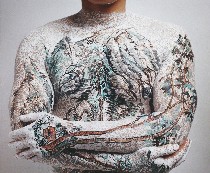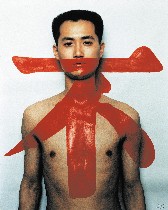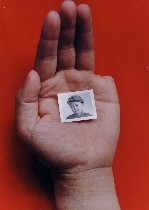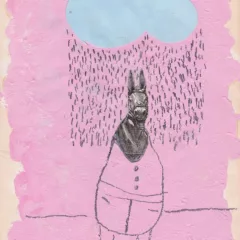
The wide gap between us and corporate America (see Roberta’s previous post in which we try to connect artblog to hotel guests) is but a crack in the sidewalk compared with the gap between today’s Chinese culture and that of 30 years ago.
On our New York outing, after the Janet Cardiff walk (see my post), we walked some more, crossing a load of sidewalk cracks to get to “Between Past and Future: New Photography and Video from China” at the International Center of Photography and the Asia Society, in New York until Sept. 5.
As Chinese culture takes in Western influences at warp speed and redefines its expectations and economy, Chinese people have a whole lot of adjusting to do. That’s the theme of the show.
The things that struck me at both venues were 1) the preponderance of body art and self-portraiture 2) the persistence of the traditional scroll shape and its story-telling qualities in media not traditionally used this way 3)the insertion of snapshots into grand images or installations.
Through it all, there’s an undercurrent of the fragility of life and the body, an irony about the official Party line and an uneasiness with Westernization. In short, China is having an identity crisis.
At the Asia Society, the two themes were “Reimagining the Body” and “History and Memory,” but I found the work, like my childhood coloring-book efforts, refused to stay within the lines. The same can be said for the themes at the ICP–“People and Place” and “Performing the Self.” Like all art, the work was rebellious.
Huang Yan’s beautiful “Chinese Landscape: Tattoo,”* (top, at the Asia Society) is not a self-portrait, but it delivers its imagery from the past on a thoroughly nontraditional substrate. It’s one of any number of pieces showing an identity with a pre-Communist homeland. Yet individuality remains masked and cut off. The body here is still that of a member of the collective.
Even so, there’s something so individualist in a body that the argument for membership in the collective falls apart. And the texture of the powder on the strong-man torso and the cropping emphasize how fragile even this strong young man is. The wash-off technique also emphasizes how fragile and ephemeral this ancient Chinese identity seems to be.
 Qiu Zhijie’s “Tattoo 1” and “Tattoo 2” (left, “Tattoo 2” according to the wall labels, “Tattoo 1” according to the documentation on my CD of images**) uses the artist’s own body to make a statement about Chinese individuality, with the irony of language silencing his voice and pinning him to the wall. Qui’s other “Tattoo” showed him looking pierced and dotted by thumbtacks. Ouch.
Qiu Zhijie’s “Tattoo 1” and “Tattoo 2” (left, “Tattoo 2” according to the wall labels, “Tattoo 1” according to the documentation on my CD of images**) uses the artist’s own body to make a statement about Chinese individuality, with the irony of language silencing his voice and pinning him to the wall. Qui’s other “Tattoo” showed him looking pierced and dotted by thumbtacks. Ouch.
Other favorite pieces at the Asia Society include Wang Wei’s underfoot lightboxes in which the viewer steps into a tunnel on images of underwater faces pressed up against the plexiglass. Suffocation was another persistent theme. And so was the invasion of Western ideals, imagery and products, displayed in Xu Yen’s interactive piece covering a wall on which cropped tidbits from porn images downloaded from the Internet are printed (in black and white) on the Post-its, that can be moved around (one dirty picture is not much different than another, and it’s cut off from the poser’s humanity).
 Typical of the dramatization of small snap shots was the show’s signature image by Sheng Qi of his hand, the pinkie cut off, with a tiny snap of himself as a child wearing his regulation cap and jacket. “Memories (Me),” (right) is a documentation of the artist separating himself from his past, his memories, a part of himself. He had cut off his finger and buried it in China before emigrating. The child and China are the lost finger.
Typical of the dramatization of small snap shots was the show’s signature image by Sheng Qi of his hand, the pinkie cut off, with a tiny snap of himself as a child wearing his regulation cap and jacket. “Memories (Me),” (right) is a documentation of the artist separating himself from his past, his memories, a part of himself. He had cut off his finger and buried it in China before emigrating. The child and China are the lost finger.
A number of heroic photos and the one video I caught mocked Maoist heroic imagery and correct Maoist thinking. The video, “Our Future is Not a Dream” by Weng Fen is a compilation of short excerpts from Mao-era Chinese feature films. The characters speak in stilted, politically correct phrases, discussing their politically correct dreams of their future.
Pretty funny.
I’m going to see if I can gather some images from the ICP before I post on that part of the show–which was far more varied than the show at the Asia Society.
*Chromogenic print, © HUANG Yan, Courtesy of Artur Walther
**Chromogenic print, © QIU Zhijie, Collection Smart Museum of Art, Chicago
***Chromogenic print, © SHENG Qi, Collection of the International Center of Photography









